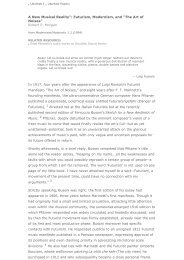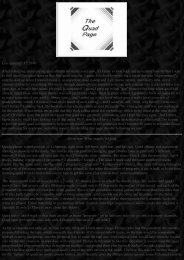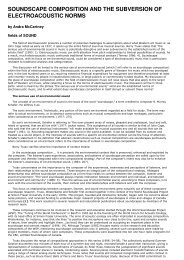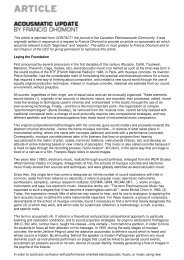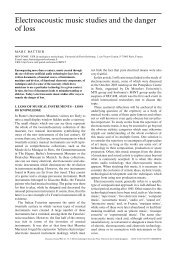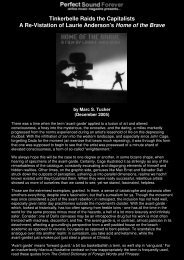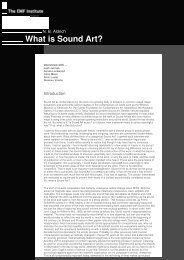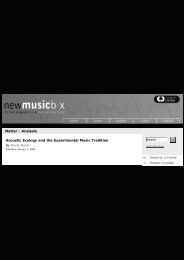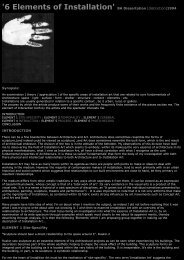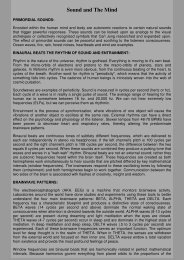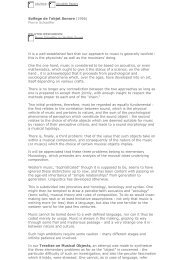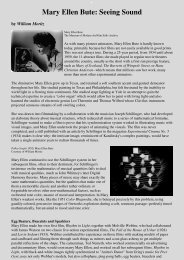Labelle-xxxx-Speaking Volumes.pdf - An International Archive of ...
Labelle-xxxx-Speaking Volumes.pdf - An International Archive of ...
Labelle-xxxx-Speaking Volumes.pdf - An International Archive of ...
- No tags were found...
You also want an ePaper? Increase the reach of your titles
YUMPU automatically turns print PDFs into web optimized ePapers that Google loves.
disorder, composition and its unravelling, sociality and its terms <strong>of</strong>commonality, for sound by nature is both an order and its ownupheaval. It points to a condition by which stability is built from aninternal incorporation <strong>of</strong> movement, eruption, and mutation. To alwaysintervene is to suggest that intervention is more a condition <strong>of</strong> movingthrough different states <strong>of</strong> energy or intensity. As Aden Evanssuggests, "sound is the difference <strong>of</strong> difference." In short, soundnever arrives on a scene devoid <strong>of</strong> an already existing dynamic, forsound is never static.To trace out sound and its process <strong>of</strong> intervention I want to look atsound art, and in particular, forms <strong>of</strong> sound art that move overtlytoward the public realm. To move from the space <strong>of</strong> the art gallery tothe realm <strong>of</strong> public space is immediately to conjure various tensions,histories, and possibilities. While it is apparent that art may find itsplace within public space, it is equally apparent that it does so with acertain amount <strong>of</strong> aggression (intentional or not). For we might ask:does the public realm need art?Various historical moments have seen art incorporated into the publicrealm as propaganda, as in the Russian Revolution <strong>of</strong> 1917, or as amode <strong>of</strong> public decoration or ornamentation, as seen in the Percentfor Art programs begun in the 1960s in the United States. Shadowingsuch legacies--from governmental propaganda to corporatedesign--we might point toward the general neo avant-garde ethos <strong>of</strong>the 1960s, which progressively sought the public throughperformance, installation, sound, and happening to overcome thelimitations <strong>of</strong> art's representational guise. To get at the heart <strong>of</strong> thereal was to also get at the heart <strong>of</strong> the public realm. From AlisonKnowles performing her Street Piece in Soho in 1962, which asks"Make something in the street and give it away", or her Color Musicseries (1963), which appropriates the street as a surface for printing,to Milan Knizak playing cello on his back in the streets <strong>of</strong> Prague(1962), which played havoc with class symbols espoused by theCommunist state, art was an aesthetic and performative surprisedisrupting the humdrum rhythms <strong>of</strong> public life. Art was a kind <strong>of</strong>un<strong>of</strong>ficial intrusion onto public spaceIn such public performances the use <strong>of</strong> sound can be heard asattraction and repulsion, whereby public appreciation is coupled withannoyance. Both <strong>of</strong> which may exist side by side in a state <strong>of</strong>compromise in front <strong>of</strong> the performing body (as in Knizak'sunabashedly poor cello playing), which is understood as a temporalpresence, that is, a momentary harangue onto the movements <strong>of</strong>daily life that may enrich or degrade (depending on your perspective)that life. Nevertheless, sound's presence within public space must beheard to raise the ante on art's public presentation. For as we know,sound carries a complex and dynamic punch that enthrals whilepotentially eliciting anger. It does so by always enacting a form <strong>of</strong>intrusion <strong>of</strong> a very complex nature, for sound invades through aseemingly subtle play while digging deep into the nerves. It may besaid to always occupy the border between pleasure and pain,performing across the spectrum <strong>of</strong> both by sending chills <strong>of</strong> bliss andshivers <strong>of</strong> misery down the spine. This may in turn be underscored asthe very core <strong>of</strong> sonorous potentiality - it may operate and define,through being both innocuous and totally invasive, the spectrum <strong>of</strong>human sensation and emotion. Such may lend to the understanding<strong>of</strong> musical power and energy, as being both individually and sociallyconstitutive <strong>of</strong> value. Music comes to define personal identity bystitching one into the emotional dynamics <strong>of</strong> sonorous intensity and itsorganization, while being granted meaning through the very sharing <strong>of</strong>



